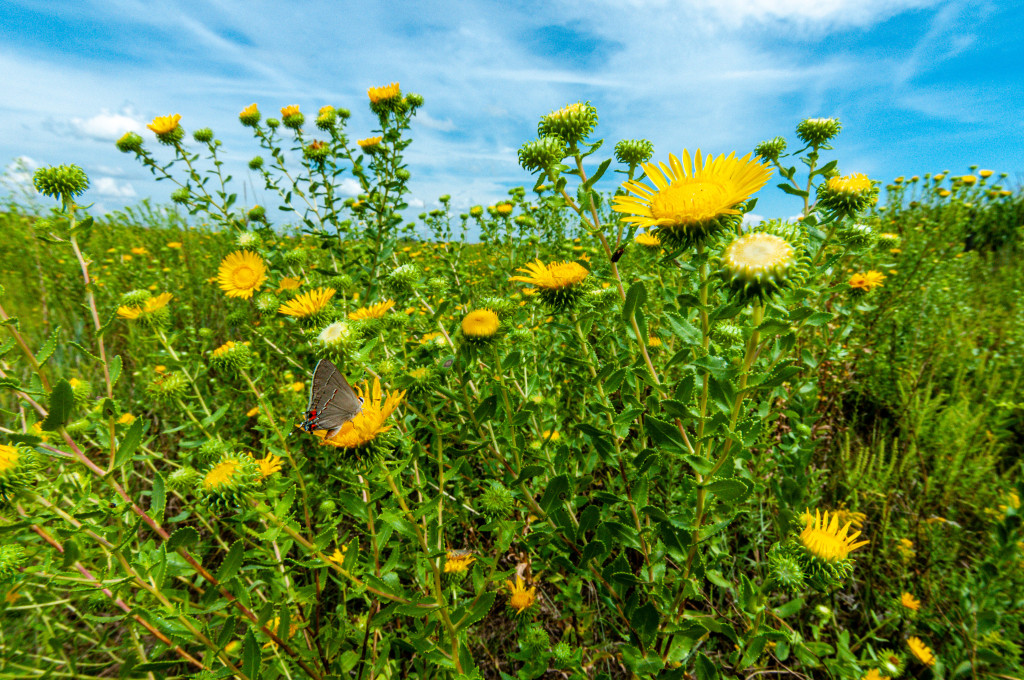
By Chris Helzer
As a short-lived plant, gumweed lives the life of a scrappy and unfairly maligned opportunist. When grasses are heavily grazed, a streambank erodes, or repeated travel creates a trail of bare ground, curlycup gumweed jumps up and says, “Hold my beer!” It can’t fight toe-to-toe with perennial grasses, but if those grasses are temporarily sidelined, gumweed can ably fill the space until the regulars can return. As a reward for its service, we label it a “worthless weed” and in some cases, actively mow it down or spray it with herbicides.
Calling gumweed a weed is like getting angry at a substitute teacher or backup quarterback because your favorite teacher or player is sick or injured. Logically, we know we should be grateful to them for stepping in, but change is hard, isn’t it? Actually, the better analogy is this: Curlycup gumweed is the cool uncle who came to babysit when your parents went to Vegas for the weekend. You knew he wouldn’t be around for long and that you’d get to eat pizza and stay up late playing video games while he was there.
My appreciation for curlycup gumweed has grown over the years, but it really skyrocketed on a late summer afternoon in 2019. I was working for a few days at the Nature Conservancy’s Niobrara Valley Preserve on the north edge of the Sandhills, and while doing butterfly surveys, I spotted a few species flitting around a patch of gumweed along a trail road in the prairie. As I came closer, I realized the butterflies were just a tiny sample of the crowd of invertebrates hanging around the flowers.
I grabbed my camera and tripod and spent a few minutes stalking the butterflies, moths, bees, flies, grasshoppers, crickets and beetles drawn to the pollen and nectar of curlycup gumweed. As I photographed them, I realized I wasn’t the only one taking advantage of the abundance of insects. Several spiders were also hanging out among the flowers, catching insects as they moved from blossom to blossom. The whole circle of life was playing out in front of me on this “worthless weed.”
Eventually, I had to get back to my real job, but I returned to the same patch of gumweed in the early evening to continue photographing the incredible diversity and abundance of invertebrates. Between the 10 minutes earlier in the day and about 45 minutes in the evening, I ended up with reasonable photos of 14 species of animals. The actual diversity of species using the flowers was much higher, though, since most hopped, dropped or flew away before I could take their picture.
My photographic inventory included two types of flies, two beetles, two butterflies, a moth, a grasshopper and a tree cricket that were all feeding on pollen and nectar. I also photographed three kinds of wild bees, including one kleptoparasitic species that lays its eggs in the nest of other bees. In addition, I got photos of two types of spiders, one using a web to catch prey and the other — a crab spider — ambushing anything that came within range of its long front legs. When I found the crab spider, it was feeding on a wasp it had just caught, which became the 15th species on my list.
As all this was happening, I was surrounded by gorgeous Sandhills prairie that stretched to the horizon in three directions and the stunning Niobrara Valley just to the north. The light was wonderful, and the wind was nearly calm. It was a perfect opportunity to explore and photograph a huge and spectacular place. Instead, I spent my time crawling around in a patch of “weeds” the size of a couple of pickup trucks and was completely enraptured.
